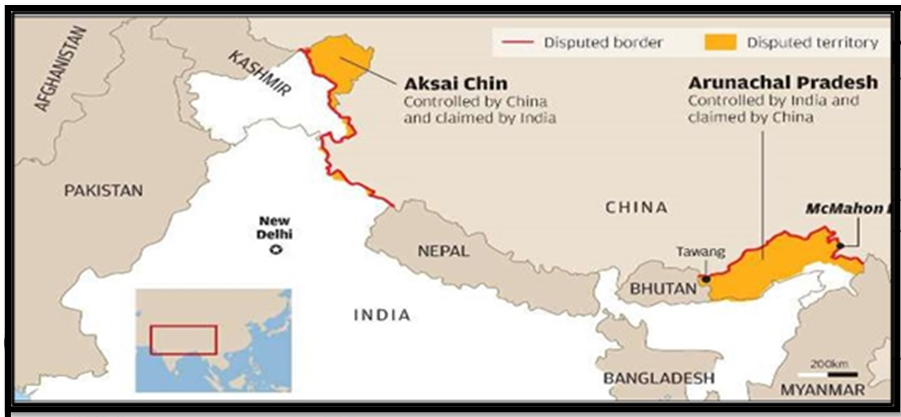RENAMING OF ARUNACHAL VILLAGES BY CHINA
Syllabus:
- GS-2-
- India and its neighbourhood
- The values of Sovereignity and non interference
Focus :
- The Chinese government declared that it will standardize the names of 30 locations in Arunachal Pradesh in an effort to assert territorial claims.
- Earlier it has done for 11 more places.
Source- IE
Introduction:
- The Chinese Ministry of Civil Affairs released the fourth list of standardised geographical names in Zangnan, the Chinese name for Arunachal Pradesh in an effort to assert terrorial claims.
- The recent statements by China to reassert its claims over the State started with Beijing lodging a diplomatic protest with India over PM Modi, where he dedicated to the nation the Sela Tunnel built at an altitude of 13,000 feet in Arunachal Pradesh.
- The tunnel will provide all-weather connectivity to strategically located Tawang and is expected to ensure better movement of troops along the frontier region.
About McMohan Line :
Historical Background:
Establishment of the McMahon Line:
|
India – China dispute :
- The biggest area under dispute, spanning around 90000 square kilometers, is the border of Arunachal Pradesh, which China asserts as its own territory.
- The People’s Liberation Army occupied it during the 1962 conflict, although they retreated in accordance with the McMahon Line after announcing a unilateral ceasefire.
- It has persisted in claiming ownership of the region, nevertheless. China now claims nearly the entirety of Arunachal Pradesh.
- The McMahon Line resulted in a significant northward shift of British control.
- It led to the cession of Tawang and other Tibetan regions to the British Empire.
- Chinese representatives initially initialed the agreement during the Shimla conference.However, they later refused to accept it.
- Chinese Position:The Chinese government does not recognize the McMahon Line, deeming it “illegal.”
- China accuses India of occupying areas in Arunachal Pradesh, which it considers part of Southern Tibet.
- Territorial Claims:China asserts territorial claims south of the McMahon Line, particularly in Arunachal Pradesh.
- These claims are partly based on historical ties between monasteries in Tawang and Lhasa.
Sovereignty
Aspects of sovereignity:
|
India’s Stand :
- India has been rejecting China renaming placesin Arunachal Pradesh, asserting that the State is an integral part of the country and assigning “invented” names does not alter this reality.
Source:
- Indian Express
- The Hindu
Mains Practice Question :
GS-2
- “Discuss the implications of China’s recent renaming of villages in Arunachal Pradesh for the India-China border dispute. How does this action affect bilateral relations between the two countries? Analyze the historical context and the broader geopolitical implications of such actions.”(250 words)
PRELIMS PRACTICE QUESTION
Which of the following statements is true regarding the India-China border dispute in Arunachal Pradesh?
a) The McMahon Line was established through mutual agreement between India and China.
b) China recognizes the McMahon Line as the legitimate border between India and China.
c) China claims territory to the south of the McMahon Line in Arunachal Pradesh.
d) Arunachal Pradesh has never been a point of contention between India and China.
Ans – (c)




